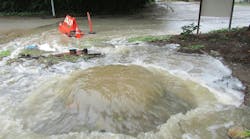Seasonally Affected
Summertime: The sun is shining, the birds are singing and the sewers are overflowing.
SWS has covered the drought in the West at length, and now it’s time to turn attention to the other side of the coin: too much rain caused by the summertime thunderstorms that can be a constant threat in some parts of the country. May was the nation’s wettest month in recorded history, and June rainfall broke records in Indiana, Illinois and Ohio. The National Oceanic and Atmospheric Administration is predicting that the rest of the summer will be wetter than normal for much of the Midwest and Southwest.
With too much rain come flash floods. Especially in the dry West, even rainfall sometimes cannot provide much relief to the drought, as the ground can be so parched that the rain runs off instead of infiltrating, creating the flash flooding often seen in states like Arizona and Texas. Other parts of the country are not immune; July saw multiple flash floods in the Northeast and Midwest, damaging property and causing injuries and even death.
Combined sewer overflows (CSOs) are another result of too much rain. There are 772 combined sewer systems in the U.S., mostly found in the Northeast, Mid-Atlantic and Great Lakes areas. Most of the time, combining storm water and sewage in the same pipeline to the treatment plant works fine, but during heavy rains, the system can be overwhelmed—and the result can pose a serious risk to human and environmental health. Contaminated drinking water, waterborne diseases, beach closures, algal blooms and basement backups all are potential effects of CSOs, and for those 772 communities, reducing or eliminating CSOs is mandated by the Clean Water Act and thus is a high priority, albeit an expensive and time-consuming one.
This is a 19th-century problem that plagues us well into the 21st century, and cities continue trying to mitigate it with grey and green infrastructure such as deep tunnel systems, green roofs, permeable pavements and other solutions. We are struggling to fix problems that have been around for hundreds of years, which speaks to the funding and education gaps our industry has faced, and continues to face; infrastructure ages while budgets tighten, and rate raises and storm water fees remain generally unpopular among the citizenry.
That we are thinking about ways to fix these issues at all, however, shows how far we’ve come since water bodies like Boston’s Charles River and New York City’s Gowanus Canal were designated Superfund sites because of the raw sewage floating in them. There has been a mentality shift since the Clean Water Act’s inception in 1972, and we’re learning that we need to be more forward-thinking than our predecessors by anticipating problems and implementing ways to fix them proactively instead of reactively. There are lots of solutions out there for our storm water and erosion control issues, and some that have yet to be invented. Keeping an open mind and staying at the forefront of new products and technologies can help create a future with cleaner, more plentiful water, and SWS can help you stay apprised.
Download: Here

